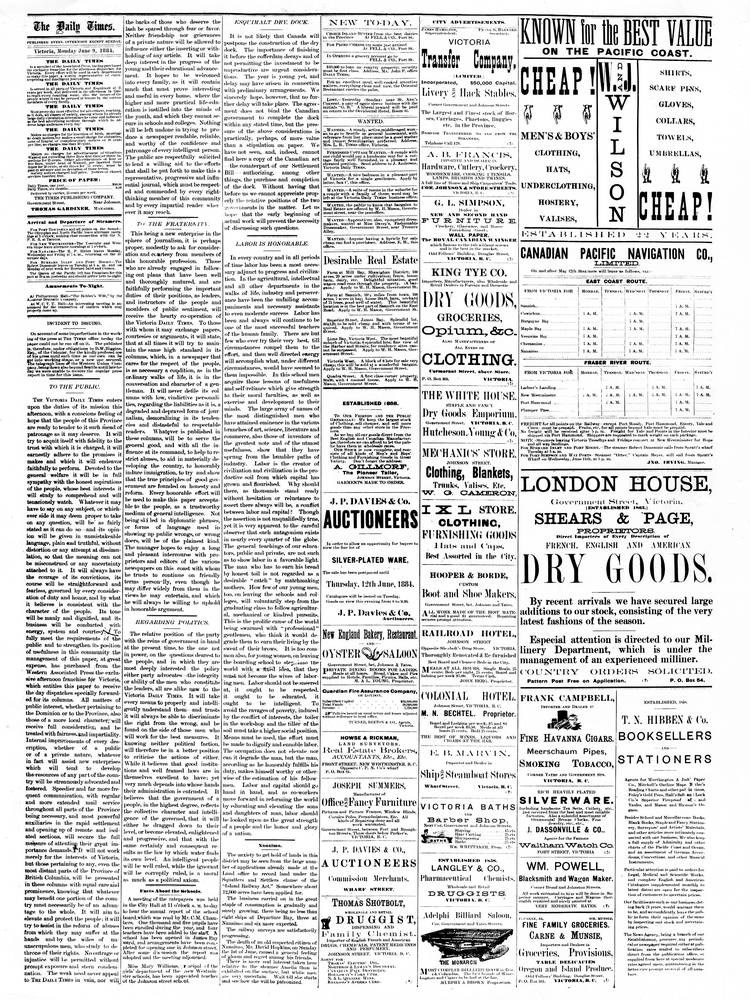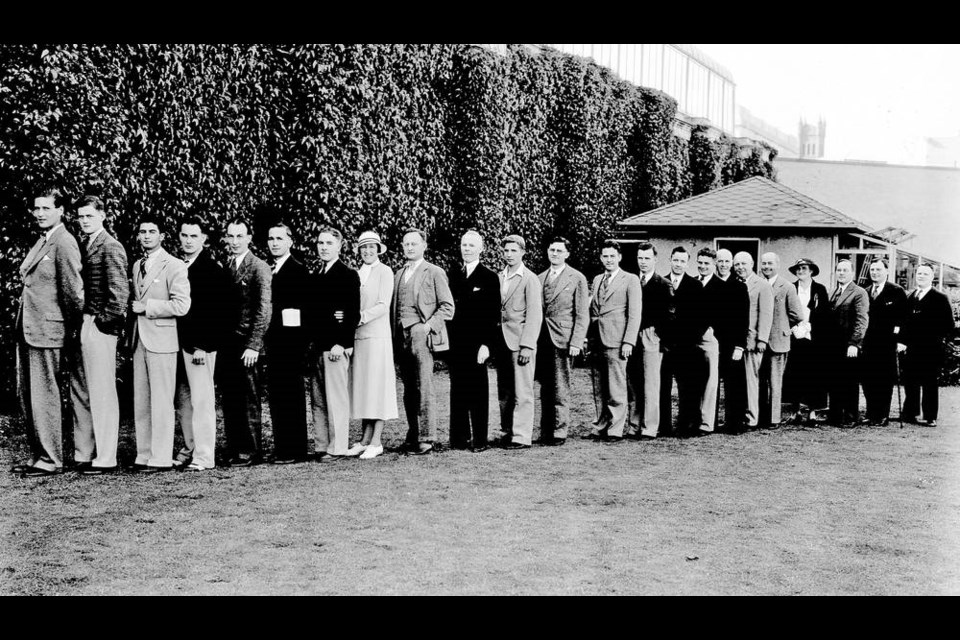 The three men who launched the Victoria Daily Times had no experience in running a news organization, but there is no doubt that they were enthusiastic about serving the community.
The three men who launched the Victoria Daily Times had no experience in running a news organization, but there is no doubt that they were enthusiastic about serving the community.
John Grant had worked in a variety of jobs, including mining, roadbuilding and general merchandising, before getting involved in the creation of the Times. Soon after the newspaper was launched he was elected to Victoria city council. In 1888 he was elected mayor.
While mayor he was elected to the provincial legislature along with his two business partners, Robert Beaven and Dr. George Lawson Milne. Grant was succeeded as mayor by Beaven, which meant that two mayors in a row served simultaneously as members of the legislature.
Grant died in Victoria in 1919.
Beaven came to Victoria via Panama and San Francisco, lured by the gold rush of 1858. He became involved in politics when there was talk of British Columbia joining the Canadian confederation, and was elected to the provincial legislature in 1871.
As commissioner of lands and works, Beaven let the contract for the first drydock in Esquimalt. He served as premier in 1882 and 1883, before getting involved in the Times.
Beaven died in 1920.
The third partner was Milne, who came to Victoria in the early 1880s after graduating with his medical degree in Toronto. He served on the school board before being elected to the legislature with Beaven and Grant.
Milne was later named the medical officer and immigration agent for the federal government in Victoria. His duties included, among other things, the collection of the head tax from Chinese immigrants.
Milne retired in 1924 and died in 1933.

Soon after the three men started the Times, a veteran newspaperman named John Campbell McLagan acquired a third of the shares. That was probably a good thing, given the lack of experience among the other partners. He agreed with their Liberal politics, which would have helped matters.
McLagan stayed in Victoria for just four years, then started another newspaper, the World, in Vancouver. When he died in 1901, the Times noted his passing with a comment about McLagan鈥檚 work in promoting Liberalism.
McLagan sold his Times shares to Harry Munn, who was involved in real estate and insurance. Munn, who died in 1939, kept his shares only a brief time, before selling them to William Templeman.
Templeman was born in Ontario in 1844, and founded the Almonte Gazette there in 1867. He sold the Gazette in 1884 and spent six months travelling before settling in Victoria, where he started working in the mechanical department of the Daily Times. Soon after he became a partner, and then took full control.
He owned the newspaper for three decades.
He was appointed a senator in 1897 and in 1902 was named minister without portfolio in Sir Wilfrid Laurier鈥檚 federal cabinet. In 1906 he became minister of internal revenue.
He invested heavily in his newspaper as it moved around the downtown core. From its first location on Government Street, the newspaper moved to Yates Street, then 26 Broad, a three-storey building between Fort Street and Trounce Alley. In 1893 he installed the best typesetting equipment available in sa国际传媒. In 1900 he set up the first photo-engraving plant in sa国际传媒, and 10 years later built the Times building at Fort and Broad streets.
When Templeman died in 1914 everyone who had worked with him for at least one year was willed one month鈥檚 salary. His death also plunged the Times into several years of uncertainty. The newspaper was run by trustees for a couple of years before Griffith R. Hughes took it over.
Hughes looked after the books for the Spencer department stores, and continued in that role after he took control of the Times. That led to his downfall.
When the Times ran short of funds, Hughes took money from the Spencer accounts to make up the difference. The end result? Hughes found himself in jail, and the Spencer family found itself owning a newspaper.
At first, the Spencers put Gerald Grattan (Gerry) McGeer in charge. McGeer, whose wife was a Spencer, later became mayor of Vancouver, and his son Pat McGeer was a Social Credit cabinet minister in the 1970s.
After McGeer, William Banks Monteith was named managing director of the Times. An accountant, Monteith remained in charge of the newspaper for a quarter of a century. He died in Vancouver in 1958, a few years after he retired.
The end of the 1940s marked the end of local ownership of Victoria鈥檚 newspapers. Both the Colonist and the Times were sold to Calgary businessman Max Bell, who merged many business functions but left the newsrooms as separate operations.
The newspapers moved together to a new building at 2631 Douglas Street, now the John Alfred Manor. Two decades later they moved next door, to 2621 Douglas, which was the home of the sa国际传媒 until the summer of 2020.
Bell鈥檚 purchase also resulted in the creation of the position of publisher, the person at the top of the local pecking order.
The first publisher at the Times was Stuart Keate, who had been Time Magazine鈥檚 bureau chief in Montreal. Under Keate鈥檚 leadership the Times sponsored community events such as the erection of the world鈥檚 tallest totem pole, a creation of Mungo Martin in Beacon Hill Park, and the first swims across Juan de Fuca Strait.
Keate left to become publisher of the Vancouver Sun from 1964 to 1979. He died in 1987.
He was succeeded at the Times by Arthur Irwin, who had been editor of Maclean鈥檚 from 1925 to 1950, and then worked as a diplomat. He remained at the Times until he retired in 1971. Irwin died in Victoria in 1999 at the age of 101.
Next came Stuart Underhill, the Times publisher from 1971 to 1978. Underhill had worked for news services around the world, including a 20-year stint in New York as the head of the North American operations of the Reuters news agency. He died in Victoria in 2003.
Underhill was succeeded by Colin McCullough, who came to Victoria in 1978 after a quarter-century rising through the ranks at the Globe and Mail in Toronto. McCullough became the first publisher of the sa国际传媒 when the two newspapers were merged in 1980.



